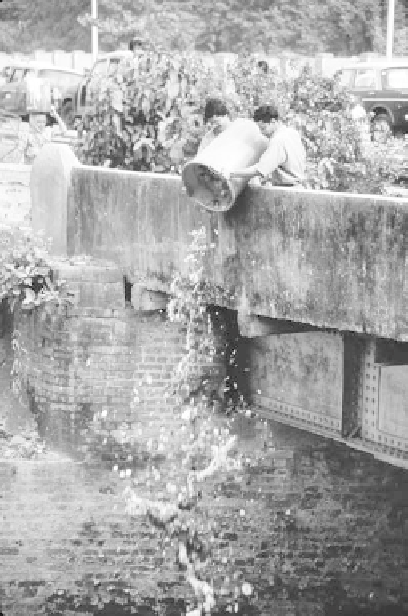Geography Reference
In-Depth Information
ing in drying or smoking the fish for commercial markets.
Part of the proceeds will go toward the purchase of more
feed and fingerlings. These “pro-poor” upland and ocean
ventures are the first of their kind in the entire country .
Fortunately , most aquaculture is still focused on rais-
ing seaweeds, shellfish, carp, and tilapia—species that are
low on the food chain. Well-designed operations can be an
effective and efficient means of adding to the global food
supply . Moreover, they can help rebuild wetlands, soak up
coastal pollution, and be used to restock wild fisheries.
Evidently , the problem does not lie with small-scale,
self-perpetuating ecosystems such as rice-mulberry or
rice-tilapia. Neither does it result from properly run, com-
mercial enterprises. The problem lies with large-scale,
carelessly run, entirely profit-oriented operations that rely
on external inputs far removed from local ecological
systems. T To quote Brian Halwell of the Worldwatch Insti-
tute (2008): “As seafood shifts from being the last wild in-
gredient in our diet to being a heavily farmed commodity ,
ocean conservationists, commercial fishers, and public
health advocates are sounding the alarm.”
GENDER AND AQUACUL TURE
Fisheries and aquaculture are diverse and often complex
dynamic systems with men and women undertaking vary-
ing roles depending on local norms regarding resource ac-
cess and control, type of technology involved, and extent
of commercialization of a particular product. Many small-
scale fisheries operate with men investing in boats, nets,
and other essential gear to do the fishing and with women
investing in processing equipment and being responsible
for fish purchasing, processing, and sales. While this is the
case in many regions of Asia, there are exceptions. For in-
stance, in Cambodia and Thailand, women are involved in
boat-fishing and in India and Bangladesh, women collect
shellfish, including crabs, and produce shellfish seed.
Regardless of gender-role differences, wealthier in-
dividuals play dominant roles in the
value chain
within which they operate (Table 5-2). A value chain is
a chain of activities in a production system in which
each activity adds value to the end product. Poor mem-
bers of the chain, who are unable to accumulate assets,
have little bargaining or purchasing power, or control
over various aspects of the chain or even their partici-
pation in it. For instance, in capture fisheries, most
men do not own boats; they serve as crews on other
men' s boats. The largest and highest quality fish go to
the boat owner.
The shrimp value chain is dominated by China, In-
donesia, Thailand, Bangladesh, and Ecuador (in South
Figure 5-9
Here, a man is dumping remnants from a fruit and vegetable mar-
ket into the Hooghly River in Calcutta. This is excellent fish food
and will boost the local fish catch.
Photograph courtesy of
B. A. Weightman.
increase small-scale aquaculture in Bangladesh by raising
fish in rice paddies, for instance, increased incomes by
20 percent.
Eight thousand fish-farm workers manage tradi-
tional ponds called
bheris
in the Kolkhata (Calcutta) wet-
lands that produce 13,000 tons of fish yearly for urban
consumption (Figure 5-9). Fish feed on 600 million liters
of raw sewage every day . The World Bank calls this system
“the city' s sewage treatment plant.” Water hyacinth ponds
and algal blooms help to clean the water.
A tilapia-raising program, recently introduced to ex-
ceedingly poor and undernourished tribal and other rice
cultivators in the Philippine highlands, has succeeded in
doubling their annual incomes. This upland project is com-
plemented with another one offshore. Another poverty-
stricken tribe has been given a spacious, steel ocean cage
along with 15,000 milkfish fingerlings. San Miguel Corpo-
ration, Southeast Asia' s largest food and drinks conglomer-
ate, has donated feed. Several NGOs have volunteered to
help the tribe manage their new fishery and provide train-


















Search WWH ::

Custom Search